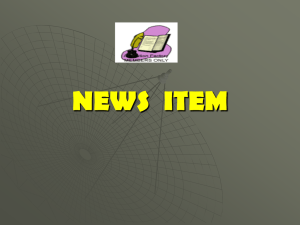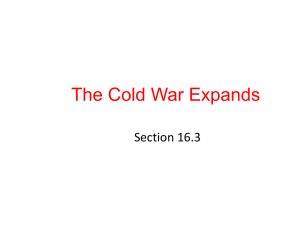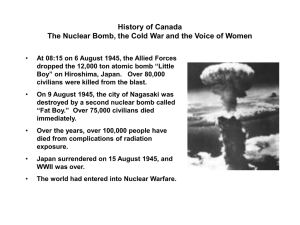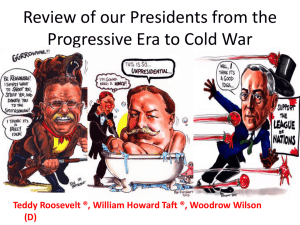L23-LivingOnBrink
advertisement
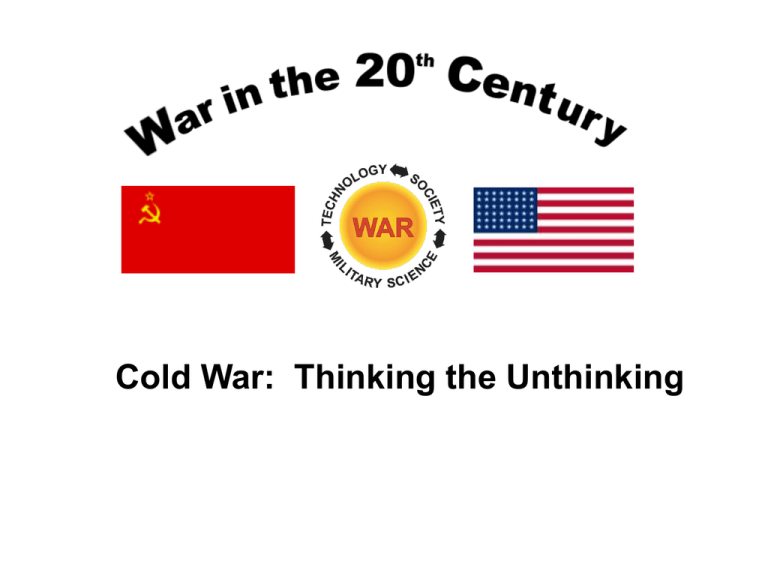
Cold War: Thinking the Unthinking Lesson Objectives • Build a foundation for understanding the genesis, issues, and strategies of the Cold War. • Understand the strategy of containment and become familiar with the conflicts and confrontations that resulted. • Be able to describe and discuss the concepts of countervalue and counterforce targeting. • Begin to understand the concept of deterrence in the Cold War. • Understand the impact of the Cold War nuclear standoff on US society. Nuclear Forces & Strategies NSC-68 April 14, 1950 Classified National Security Council document Full analysis of US-USSR relationship Defined initial US Cold War strategy: Containment Implemented the Truman Doctrine Note: Korean War began June 25, 1950 Impact of NSC-68 Immediate increase in defense spending FY 1950: Defense budget $14.1 billion 33% of national budget, 5% 0f GNP FY 1951: Defense budget $33.6 billion 73% of national budget, 10% 0f GNP Demonstrated American commitment to win the Cold War Source Impact of NSC-68 Source US Cold War Policy Stem the tide of worldwide Soviet expansionism Insure security of Europe through a strong NATO Prevent global nuclear war through deterrence • Emphasis on defense Colonel John Osgood, USA, Retired United States Nuclear Strategy 1945-1995 US Cold War Policy Stem the tide of worldwide Soviet expansionism Insure security of Europe through a strong NATO Prevent global nuclear war through deterrence • Emphasis on defense Colonel John Osgood, USA, Retired United States Nuclear Strategy 1945-1995 Nuclear Targeting Theories Counterforce : target warfighting capability Countervalue : target cities and industry Nuclear Targeting Strategies Truman: Countervalue • US had nuclear monopoly, then preeminence • Believed nuclear weapons most valuable against cities Eisenhower: Counterforce • Soviet nuclear weapons became a concern • Massive retaliation was public doctrine Kennedy/Johnson: Flexible Response • Public face: assured destruction (countervalue) • Counterforce (war fighting) retained as an option Colonel John Osgood, USA, Retired United States Nuclear Strategy 1945-1995 Nuclear Targeting Strategies Nixon: Counterforce • Publicly promoted position • Developed warfighting weapons (MIRV, ABM) Carter: Counterforce • Pursued decapitation strategy (targeted C3, leadership) Regan/Bush: Counterforce • Combined counterforce and strategic defense • Blended arms negotiations (SALT) with SDI Colonel John Osgood, USA, Retired United States Nuclear Strategy 1945-1995 Implementing the Strategy Initially: World War II technology Implosion type A-bombs B-29 Superfortress Combat Radius: Later: B-29 - 1,800 nm B-50 - 2,050 nm Both required forward basing B-50 Superforress Strategic Bombers Max Weight: 410,000 lbs Radius: 3,750 nm w/ 10,000 lbs bomb load B-36 Peacemaker Strategic Bombers B-17 B-29 B-36 Comparison of Bombers Strategic Bombers Max Weight: 233,000 lbs Radius: 2,050 nm Over 2,000 built by Boeing, Douglas, Lockheed B-47 Stratojet Takeoff clip LABS* Maneuver * Low Altitude Bombing System Aerial refueling from KC-97 Strategic Bombers Max Weight: 410,000 lbs Radius: 3,750 nm w/ 10,000 lbs bomb load YB-52 prototype (1952) B-52 Stratofortress 744 built B-52H models (delivered 1963) still flying B-52G Soviet Bombers Soviet Special Weapon (?) Tu-4 Bull Copy of US B-29 Chinese-operated Tu-4 with turboprop engines and Chinese copy of US AQM-34 Firebee UAV Soviet Bombers Tu-95 Bear Max Weight: 400,000 lbs Radius: 7,600 nm FAS Soviet Bombers M-4 Bison Max Weight: 365,000 lbs. Radius: 2,500 nm Cold War Timeline 9 Sep 48 Stalin declares PDRK legitimate government of all Korea 4 Apr 49 North Atlantic Treaty Organization (NATO) established 11 May 49 Berlin Blockade lifted 29 Aug 49 Soviet Union detonates first nuclear device 12 Jan 50 Sec State Acheson speech omits Korea as US interest area 14 Feb 50 USSR & PRC sign mutual defense pact 14 Apr 50 NSC-68: Blueprint for containment strategy 25 Jun 50 North Korea (PDRK) invades South Korea (ROK) Cold War Timeline 9 Sep 48 Stalin declares PDRK legitimate government of all Korea 4 Apr 49 North Atlantic Treaty Organization (NATO) established 11 May 49 Berlin Blockade lifted 29 Aug 49 Soviet Union detonates first nuclear device 12 Jan 50 Sec State Acheson speech omits Korea as US interest area . 50 31 14 Jan Feb . USSR & announces PRC sign mutual defense pact Truman US intent to develop hydrogen bomb 14 50 14 Feb Apr 50 USSR & Blueprint PRC signfor mutual defense strategy pact NSC-68: containment 14 Jun Apr 50 25 NSC-68: Blueprint forinvades containment North Korea (PDRK) Southstrategy Korea (ROK) 25 Jun 50 North Korea (PDRK) invades South Korea (ROK) Cold War Timeline Nuclear War Branch 31 Jan 50 Truman announces US intent to develop hydrogen bomb 14 Apr 50 NSC-68: Blueprint for containment strategy These two events take on new significance when considered together Cold War Timeline Nuclear War Branch 31 Jan 50 Truman announces US intent to develop hydrogen bomb Two events drove this decision • Soviet detonation of a nuclear device (29 Aug 49) • Discovery of a Soviet spy at Los Alamos (Klaus Fuchs) Concerned US might be overtaken in a nuc arms race It is part of my responsibility as Commander in Chief of the Armed forces to see to it that our country is able to defend itself against any possible aggressor. Accordingly, I have directed the AEC to continue its work on all forms of atomic weapons, including the so-called hydrogen or Super bomb. President Harry S. Truman, 31 January 1950 nuclearweaponarchive.org Cold War Timeline Nuclear War Branch 31 Jan 50 Truman announces US intent to develop hydrogen bomb 14 Apr 50 NSC-68: Blueprint for containment strategy Two events drove this decision • Soviet detonation of a nuclear device (29 Aug 49) • Discovery of a Soviet spy at Los Alamos (Klaus Fuchs) Concerned US might be overtaken in a nuc arms race It is part of my responsibility as Commander in Chief of the Armed forces to see to it that our country is able to defend itself against any possible aggressor. Accordingly, I have directed the AEC to continue its work on all forms of atomic weapons, including the so-called hydrogen or Super bomb. President Harry S. Truman, 31 January 1950 nuclearweaponarchive.org Cold War Timeline Nuclear War Branch 31 Jan 50 Truman announces US intent to develop hydrogen bomb 14 Apr 50 NSC-68: Blueprint for containment strategy NSC-68 and resulting spending increase largely the result of decision to develop H-bomb Cold War Timeline Nuclear War Branch 31 Jan 50 Truman announces US intent to develop hydrogen bomb 14 Apr 50 NSC-68: Blueprint for containment strategy 1 Nov 52 First thermonuclear device detonated, Enewetak Atoll, Marshall Islands Mike Shot Operation Ivy series November 1, 1952 Fireball Mushroom cloud First hydrogen bomb - 10.4 megatons nuclearweaponarchive.org A-bomb Mechanics Nuclear “Pit” H-bomb Mechanics Physics Package H-bomb Mechanics W53 (9 MT) Physics Package Mike Shot Operation Ivy series November 1, 1952 First Thermonuclear (Fusion) Device 10 MT Video Mike Shot Operation Ivy series November 1, 1952 Before After Elugelab Island, site of “Mike”device nuclearweaponarchive.org Thermonuclear Breakthrough “Mike” test and subsequent work in the next four years led to the development and fielding of significantly smaller, more powerful weapons Mk 17 - 15 MT (1955) W-38 - 3.75 MT (1961) Mk 4 RV (re-entry vehicle Nuclear “Progress” Nuclear Weapons Mk 39 - 4 MT Mk 41 - 25 MT Highest yield US weapon Nuclear Weapons Mk 28 - variable yield 70 KT - 1.45 MT Nuclear Weapons Soviet 100 MT bomb (rear) and 152 mm artillery shell (front) Nuclear Weapons US Nuclear Weapon Designations http://nuclearweaponarchive.org/Usa/Weapons/Allbombs.html Ballistic Missiles Go to Ballistic Missiles Terminology SRBM: Short Range Ballistic Missile ( ≤ 1,000 km ) MRBM: Medium Range Ballistic Missile ( 1,000 – 3,000 km ) IRBM: Intermediate Range Ballistic Missile ICBM: Intercontinental Ballistic Missile ( 3,000 – 5 ,000 km ) ( > 5,000 km ) SLBM: Submarine-Launched Ballistic Missile First Ballistic Missiles German V-2 Range ~ 175 nm CEP*: 11 nm * Circular Error Probable Cold War Timeline Nuclear War Branch 31 Jan 50 Truman announces US intent to develop hydrogen bomb 14 Apr 50 NSC-68: Blueprint for containment strategy 1 Nov 52 First thermonuclear device detonated, Enewetak Atoll, Marshall Islands 4 Oct 57 USSR launches first earth satellite, Sputnik Sputnik October 4, 1957 R-7 / SS-6 Sapwood ICBM Early Earth Satellites March 17, 1958 January 31, 1958 October 4, 1957 Early Missiles Sputnik Explorer Deployed U.S. Missiles Jupiter MRBM Thor IRBM Deployed to Italy & Turkey Deployed to the UK Range ~ 1,500 nm CEP: 0.6 nm U.S. ICBMs Atlas Titan I Titan II Minuteman Peacekeeper ICBM Minuteman with MIRV Nuclear Triad Manned Bombers Can launch on warning Accurate Flexible ICBM Quick response Invulnerable inflight Accurate Economical Vulnerable to first strike Vulnerable inflight Slow SLBM Survivable Quick response Invulnerable inflight Unpredictable Expensive system Nuclear Forces SAC (c 1950) Cassette 42: Modern Marvels Fighting a Nuclear War Issues: Warfighting Strategy Nuclear Targeting Strategies Nixon: Counterforce • Publicly promoted position • Developed warfighting weapons (MIRV, ABM) Carter: Counterforce • Pursued decapitation strategy (targeted leadership, C3) Regan/Bush: Counterforce • Combined counterforce and strategic defense initiative (SDI) • Blended arms negotiations (SALT) with SDI Colonel John Osgood, USA, Retired United States Nuclear Strategy 1945-1995 Fighting a Nuclear War Issues: Warfighting Strategy Second Strike Capability Retaliatory forces must be able to ride out a first strike and still respond with decisive force Survivability becomes key consideration Sea-Based Deterrent Ohio-class SSBN Fighting a Nuclear War Issues: Warfighting Strategy Second Strike Capability Continuity of Government Continuity of Government Objective: Maintain post-attack constitutional government Undisclosed Locations Video Airborne Command Post E-4B Provide continuity for the National Command Authority Looking Glass EC-135 Looking Glass Fighting a Nuclear War Issues: Warfighting Strategy Second Strike Capability Continuity of Government War Plan SIOP Single Integrated Operational Plan SIOP: Single Integrated Operational Plan "The Circle of Modern War" and logo © Thomas D. Pilsch 2007-2013 Cold War: Defending the Homeland Air Defense & Civil Defense Go To The Threat 1950’s on: Manned Bombers 1960’s on: Ballistic Missiles • Land-based ICBM’s initially • SLBM’s* added later * Submarine-Launched Ballistic Missile Defense Options Deter the Threat: Effective, secure nuclear forces Defeat the Threat: Active Defenses (aircraft, missiles) Mitigate the Threat: Passive Defenses (civil defense, dispersal, continuity of government) Active Defense 288 site in 30 states San Francisco SAM sites Each missile had a nuclear warhead Variable yield: 2 – 40 KT Civil Defense Living With the Bomb Civil Defense Information Survival Under Atomic Attack (1950) (9:00) Civil Defense January 12, 1962 Civil Defense Civil Defense “Duck and cover!” Civil Defense Updated Video (9:16) Civil Defense Cold War: Cuban Missile Crisis Vietnam: Into the Abyss Lesson Objectives • Understand the Vietnam War as part of the Cold War. • Be able to describe the evolution of U.S. policy toward Indochina from Presidents Roosevelt to Eisenhower. • Understand and describe the challenges posed by the Democratic Republic of Vietnam (DRV) against the south. • Understand and describe the situation in the Republic of Vietnam (RVN) after 1959 and the RVN reaction to the challenge from the north. • Understand the doctrine of limited war and counterinsurgency as espoused by the Kennedy Administration. • Understand the timeline of events that led to U.S. involvement in Southeast Asia. End

![The Politics of Protest [week 3]](http://s2.studylib.net/store/data/005229111_1-9491ac8e8d24cc184a2c9020ba192c97-300x300.png)


